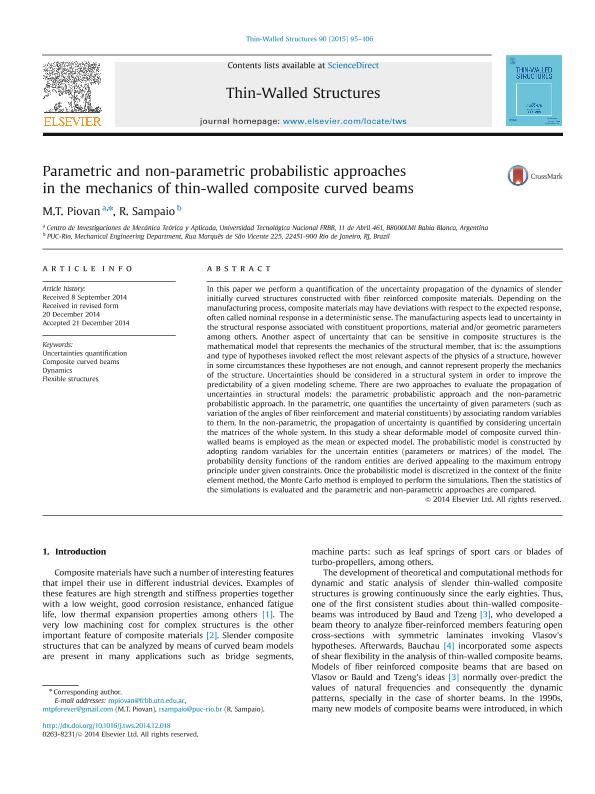Artículo
Parametric and non-parametric probabilistic approaches in the mechanics of thin-walled composite curved beams
Fecha de publicación:
05/2015
Editorial:
Elsevier
Revista:
Thin-walled Structures
ISSN:
0263-8231
Idioma:
Inglés
Tipo de recurso:
Artículo publicado
Clasificación temática:
Resumen
In this paper we perform a quantification of the uncertainty propagation of the dynamics of slender initially curved structures constructed with fiber reinforced composite materials. Depending on the manufacturing process, composite materials may have deviations with respect to the expected response, often called nominal response in a deterministic sense. The manufacturing aspects lead to uncertainty in the structural response associated with constituent proportions, material and/or geometric parameters among others. Another aspect of uncertainty that can be sensitive in composite structures is the mathematical model that represents the mechanics of the structural member, that is: the assumptions and type of hypotheses invoked reflect the most relevant aspects of the physics of a structure, however in some circumstances these hypotheses are not enough, and cannot represent properly the mechanics of the structure. Uncertainties should be considered in a structural system in order to improve the predictability of a given modeling scheme. There are two approaches to evaluate the propagation of uncertainties in structural models: the parametric probabilistic approach and the non-parametric probabilistic approach. In the parametric, one quantifies the uncertainty of given parameters (such as variation of the angles of fiber reinforcement and material constituents) by associating random variables to them. In the non-parametric, the propagation of uncertainty is quantified by considering uncertain the matrices of the whole system. In this study a shear deformable model of composite curved thinwalled beams is employed as the mean or expected model. The probabilistic model is constructed by adopting random variables for the uncertain entities (parameters or matrices) of the model. The probability density functions of the random entities are derived appealing to the maximum entropy principle under given constraints. Once the probabilistic model is discretized in the context of the finite element method, the Monte Carlo method is employed to perform the simulations. Then the statistics of the simulations is evaluated and the parametric and non-parametric approaches are compared.
Archivos asociados
Licencia
Identificadores
Colecciones
Articulos(CCT - BAHIA BLANCA)
Articulos de CTRO.CIENTIFICO TECNOL.CONICET - BAHIA BLANCA
Articulos de CTRO.CIENTIFICO TECNOL.CONICET - BAHIA BLANCA
Citación
Sampaio, Rubens; Piovan, Marcelo Tulio; Parametric and non-parametric probabilistic approaches in the mechanics of thin-walled composite curved beams; Elsevier; Thin-walled Structures; 90; 5-2015; 95-106
Compartir
Altmétricas




